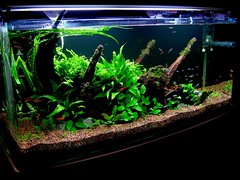in RHM...
Due to some miscommunication the just-before-final edit was published (no blame implied towards the RHM team; in fact, great job RHM!), but the message was essentially the same to residents of Raffles Hall. For the sake of you who were not able to get your hands on a copy of the Raffles Hall Magazine (RHM), here is the final edit of the article for your reading pleasure.
Enjoy...
----------------------- start of article/interview--------------------
The RH Fish Tank
It has been a while since I have seen things lively around Raffles Hall. There have been times when residents have tried to add ‘life’ to the hall but without success; the pond/fountain at the entrance of our hall was one of those failed missions. However, this semester brings a change to that: we have all seen the testament to that – the lively fish tank situated in front of the office.
The RH Fish Tank is maintained with care and pride by mainly two residents – Daniel, Daniel Kwok and Kok Tiong. The idea of having a RH residents’ fish tank was started by Daniel, Daniel Kwok. He was the main powerhouse who instigated the whole process. Now that we are reaching the end of the semester, what’s going to happen to the RH Fish Tank? If you haven’t already realized, Daniel, Daniel Kwok is a final year and won’t be around next year. The tank needs daily care as well as funds – so who’s going to be taking over? No one can answer these questions better than Daniel, Daniel Kwok himself.
Hi Daniel (Daniel Kwok)!
- Before going on to the more important issues, can you tell us why you wanted to put a fish tank in the Comm Hall? You have several tanks in your room filled with shrimps and fish already, so why another one in Comm Hall?
- How much does it cost to actually maintain the tank?
How do you get the funds all this while? - Also, there are some concerns about the ownership of the fish tank. Is it yours, Kok Tiong’s, Raffles Hall, or the residents'?
- What’s going to happen after you leave?
- How can residents help to maintain the tank?
- On a lighter note, did you know that some residents actually name the fish after a few fellow residents? One of the newer fish – the biggest one (Betta Fusca) - is named ‘Sam’. Does ‘Sam’ take up too much space or eat up other fish?
- Which fish is the hardest to take care of? Is it the Chocolate Gourami? It seems to be a ‘high maintenance’ sort of fish.
- Do you encourage other residents to have their own fish tank? Why or why not?
- RH Fish Tank also has its own personal blog. Can you tell us more about that?
- Hmm, so how do the residents donate to the RH Fish Tank?
- Any last words to the residents?



 account!
account!


